In preparation for Thanksgiving dinner next week, the Distinctive Collections staff have gathered together a sampling—a tasting menu, as it were—of food-related items from their respective collections. This playful buffet reflects the breadth and depth of holdings in the Distinctive Collections units, and, we hope, will whet the appetites of researchers for more.
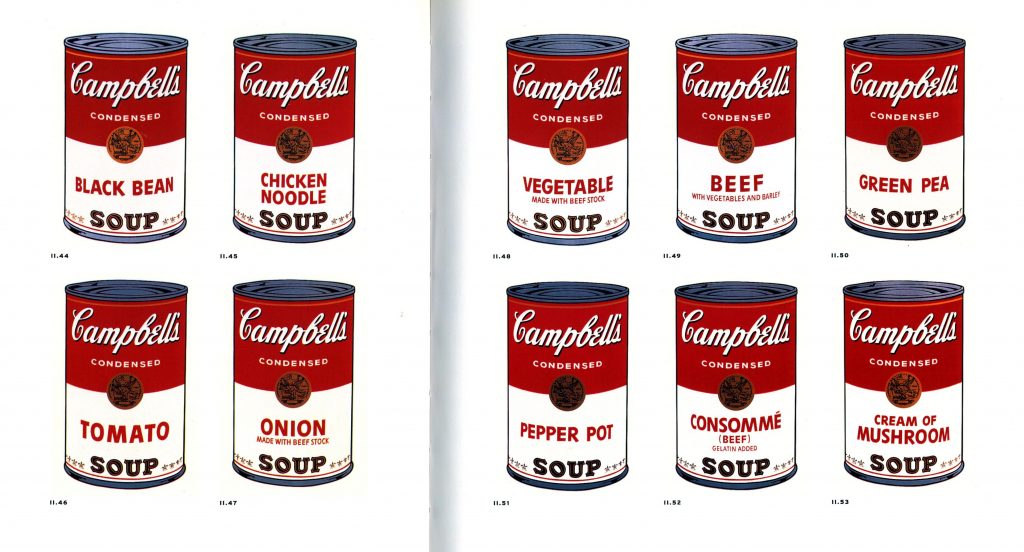
ART LIBRARY
Food and art have a long and intimate history, from the New Year’s feast depicted in the 15th century book of hours Les Tres Riches Heures du Duc de Berry, through Pierre Renoir’s Luncheon of the Boating Party, and continuing in the contemporary installations of Felix Gonzalez-Torres (or, if you’re really adventurous, Carolee Schneemann’s Meat Joy). One of the most famous examples, and one with wh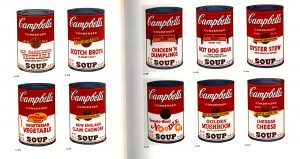 ich almost everyone is familiar is Andy Warhol’s Campbell’s Soup can, a groundbreaking screenprint that took a common grocery store item rendered with commercial technology and transformed it into art. What is less well known is that Warhol played no favorites, and enjoyed not just tomato soup, but the complete range of Campbell’s varieties, as seen here. These images represent just two different variations on the Campbell’s theme that Warhol explored; others included images of opened cans, sketched cans, or repeated images of 100 and even 200 cans. Apparently, Warhol really liked his soup. All that soup is bound to make you thirsty, and what better way to satisfy that thirst than with Coca-Cola. If you’re Warhol, though, one bottle just won’t do. —Perry Nigro
ich almost everyone is familiar is Andy Warhol’s Campbell’s Soup can, a groundbreaking screenprint that took a common grocery store item rendered with commercial technology and transformed it into art. What is less well known is that Warhol played no favorites, and enjoyed not just tomato soup, but the complete range of Campbell’s varieties, as seen here. These images represent just two different variations on the Campbell’s theme that Warhol explored; others included images of opened cans, sketched cans, or repeated images of 100 and even 200 cans. Apparently, Warhol really liked his soup. All that soup is bound to make you thirsty, and what better way to satisfy that thirst than with Coca-Cola. If you’re Warhol, though, one bottle just won’t do. —Perry Nigro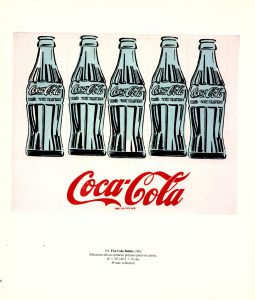
TRANSPORTATION LIBRARY
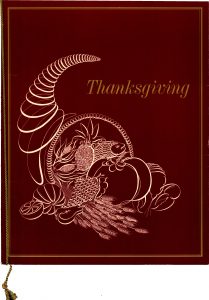 “Good food is the basis for true happiness.” Pan Am’s choice of Auguste Escoffier’s quote, which was printed inside the first-class menu distributed by
“Good food is the basis for true happiness.” Pan Am’s choice of Auguste Escoffier’s quote, which was printed inside the first-class menu distributed by  the airline on Thanksgiving Day 1968, represents an era of elevated cuisine for in-flight dining. Passengers would have enjoyed a fine traditional Thanksgiving feast from Maxim’s of Paris on their flight from Miami to Trinidad and Tobago. The President Special menu began with apple cider followed by hors d’oeuvres of celery and olives or Virginia ham and melon, with a choice of entrée: roast tom turkey with chestnut dressing, or broiled filet mignon. Thanksgiving dinner in the sky ended with dessert selections of pumpkin pie, a fruit basket, and assorted nuts. The menu was a gift to the Transportation Library from noted anthropologist and Northwestern alum George M. Foster. It is part of the Transportation Library Menu Collection, which has been digitized and can be fully accessed online. —Rachel Cole
the airline on Thanksgiving Day 1968, represents an era of elevated cuisine for in-flight dining. Passengers would have enjoyed a fine traditional Thanksgiving feast from Maxim’s of Paris on their flight from Miami to Trinidad and Tobago. The President Special menu began with apple cider followed by hors d’oeuvres of celery and olives or Virginia ham and melon, with a choice of entrée: roast tom turkey with chestnut dressing, or broiled filet mignon. Thanksgiving dinner in the sky ended with dessert selections of pumpkin pie, a fruit basket, and assorted nuts. The menu was a gift to the Transportation Library from noted anthropologist and Northwestern alum George M. Foster. It is part of the Transportation Library Menu Collection, which has been digitized and can be fully accessed online. —Rachel Cole
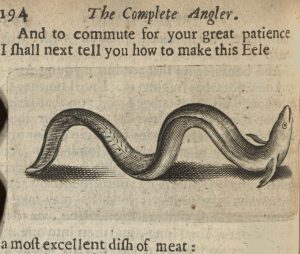
CHARLES DEERING McCORMICK LIBRARY OF SPECIAL COLLECTIONS
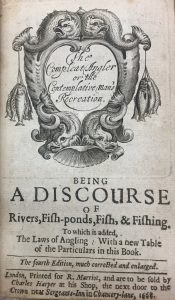 Just in time for Thanksgiving, here is a 17th century recipe for roasted eel! It comes from The Compleat Angler, 4th edition, London: 1668, by Izaak Walton. Offering much more than merely the technical advice for how to catch (and cook) a great variety of fishes, Walton presents a contemplative investigation of man’s place in nature and touts the spiritual and social benefits of angling as a way of life. This book is part of the Joseph Spear Beck Angling Collection.
Just in time for Thanksgiving, here is a 17th century recipe for roasted eel! It comes from The Compleat Angler, 4th edition, London: 1668, by Izaak Walton. Offering much more than merely the technical advice for how to catch (and cook) a great variety of fishes, Walton presents a contemplative investigation of man’s place in nature and touts the spiritual and social benefits of angling as a way of life. This book is part of the Joseph Spear Beck Angling Collection.
“And to commute for your great patience I shall next tell you how to make this Eele a most excellent dish of meat: First, wash him in water and salt, then pull of his skin below his vent or navel, and not much further: having done that, take out his guts as clean as you can, but wash him not: then give him three or four scotches with a knife, and then put into his belly and those scotches sweet herbs, an Anchovy, and a little Nutmeg grated or cut very small, and your herbs and Anchovis must also be cut very small, and mixt with good Butter and salt: having done this, then pull his skin over him all but his head, which you are to cut off, to the end you may tie his skin about that part where his head grew, and it must be so tyed as to keep all his moisture within his skin : and having done this, tie him with Tape or Pack-thred to a spit, and rost him leasurely, and baste him with water and salt till his skin breaks, and then with Butter: and having rosted him enough, let what was put into his belly, and what he drips be his sawce.” —Jason Nargis
ARCHIVAL PROCESSING
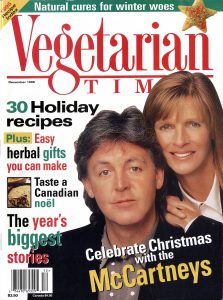 Archival Processing presents a meat-free option with this holiday issue of Vegetarian Times from December 1995. Archival Processing staff member Gary Strawn is working with the Music Library to process the James Rosen Beatles Literature Collection, which includes almost 2,000 items making mention of the Beatles and its members. A vegetarian Christmas dinner with the McCartney family includes such recipes as Cheese and Nut Pâté, Festive or Sunday “Roast” with Savory Stuffing, and Bakewell Tart. —Jill Waycie
Archival Processing presents a meat-free option with this holiday issue of Vegetarian Times from December 1995. Archival Processing staff member Gary Strawn is working with the Music Library to process the James Rosen Beatles Literature Collection, which includes almost 2,000 items making mention of the Beatles and its members. A vegetarian Christmas dinner with the McCartney family includes such recipes as Cheese and Nut Pâté, Festive or Sunday “Roast” with Savory Stuffing, and Bakewell Tart. —Jill Waycie
UNIVERSITY ARCHIVES
The Archives holds a cornucopia of scrapbooks created by past Northwestern students, dating between the 1890s and 1940s. The scrapbooks reveal the secret life of student through newspaper clippings, ticket stubs, dance cards, photos and their captions, and such telling mementos as handkerchiefs and traffic tickets. Not surprisingly, food has a significant place in student memories (remember gaining the “freshman 15” or cadging food at conferences as a grad student?).
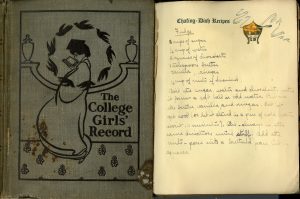 Helen Paddock (BA 1914, MA 1915) purchased or was given a scrapbook called The College Girls’ Record, consisting of pages with pre-printed topics (class cheers, favorite prof, etc.) and space for the owner to write or paste items in. Helen dutifully filled every page, leaving us a vivid picture of the life of a 1910s “co-ed.” Dinner parties were common enough among college students of the time that Helen’s scrapbook included a page for “Snap Shots of Our Spreads.” The following page, labeled “Chafing-Dish Recipes,” indicates that students found creative, not to say inflammable, ways of preparing tasty dishes in their dorm rooms. Helen’s entry is a detailed recipe for fudge—doubtless a frequent favorite. One interesting note about her recipe, though, is that Helen did not live in a dorm at all. She came from an Evanston family and lived at home—where she often hosted “spreads” for her sorority sisters—and probably did not have much opportunity to make chafing-dish fudge.
Helen Paddock (BA 1914, MA 1915) purchased or was given a scrapbook called The College Girls’ Record, consisting of pages with pre-printed topics (class cheers, favorite prof, etc.) and space for the owner to write or paste items in. Helen dutifully filled every page, leaving us a vivid picture of the life of a 1910s “co-ed.” Dinner parties were common enough among college students of the time that Helen’s scrapbook included a page for “Snap Shots of Our Spreads.” The following page, labeled “Chafing-Dish Recipes,” indicates that students found creative, not to say inflammable, ways of preparing tasty dishes in their dorm rooms. Helen’s entry is a detailed recipe for fudge—doubtless a frequent favorite. One interesting note about her recipe, though, is that Helen did not live in a dorm at all. She came from an Evanston family and lived at home—where she often hosted “spreads” for her sorority sisters—and probably did not have much opportunity to make chafing-dish fudge.
See the finding aid for more information about Helen’s life and her scrapbook. —Janet Olson
MELVILLE J. HERSKOVITS LIBRARY OF AFRICAN STUDIES
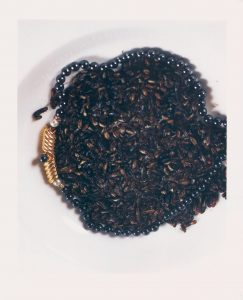
 This, Thanksgiving, how about a hearty serving of tsiswa to go along with your Turkey? No carving needed!
This, Thanksgiving, how about a hearty serving of tsiswa to go along with your Turkey? No carving needed!
Tsiswa (Luhya, Kenya)
Ingredients
I cup fresh flying termites
2 tsp oil
Salt to taste
Method
Put the live termites in water, which makes them unable to fly. Then heat the oil in a pan and fry the termites on low heat until crispy and well done. Season with salt. Eaten as a snack. During the rainy season termites are trapped by the children using a blanket as they beat the ground with sticks to drive them out.
Source
Let’s Cook Kenya, Susan Kamau, 2013. —Florence Mugambi
MUSIC LIBRARY
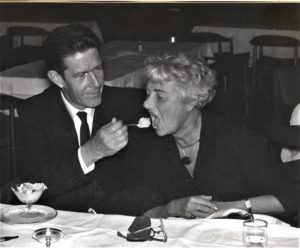 In 1962, composer John Cage made his first trip to Japan on a month long tour sponsored by the Sogetsu Art Center in Tokyo. He was accompanied by a few friends including Peggy Guggenheim. The two had been close for years by the time of the 1962 tour, and Cage invited her because she had always wanted to visit Japan. In this photo, the two are seen sharing a bit of cake. —Greg MacAyeal
In 1962, composer John Cage made his first trip to Japan on a month long tour sponsored by the Sogetsu Art Center in Tokyo. He was accompanied by a few friends including Peggy Guggenheim. The two had been close for years by the time of the 1962 tour, and Cage invited her because she had always wanted to visit Japan. In this photo, the two are seen sharing a bit of cake. —Greg MacAyeal
